In 1971, Wakefield Poole created a sensation when he and producer Marvin Shulman released the gay porn film Boys in the Sand at the 55th Street Playhouse in New York City. Producer Wakefield Poole placed ads in, and got the film reviewed by, both the New York Times and Variety.
Later that year, J. Brian's gay porn film Seven in a Barn showed at this same location.
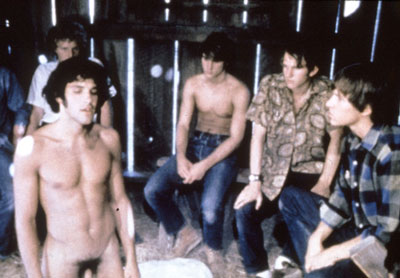
Why was the 55th Street Playhouse in New York City such a prime location for showing these films in the early days of gay liberation?
Actually, if one envisions a seedy place with cum-stained seats like a person might see at that time on 42nd Street (I'm thinking of the whole Midnight Cowboy scenario), the Playhouse did not fit that bill. In fact, in most of its long history as a cinema, it did not show pornography, much less gay porn.
This Romanesque Revival structure was built as a horse stable in 1888, designed by E. Bassett Jones. In 1927 it was converted into a small cinema by Treanor & Fatio, and became known as the 55th Street Playhouse.
In 1930, it opened Two Hearts in Waltz Time, a German film and the first foreign language film subtitled for U.S. release. The novelty paid off and the film ran for a year.
In March 1931, during that run the theater was renamed Europa, a name it kept until late 1933 when it started to also show more mainstream films.
The theater saw the premieres of groundbreaking films as Abel Gance's Napoleon and Cocteau's Orpheus.
In the 1950s, Ilya Lopert operated the place, where it became a main distributor for foreign films. For example, in 1952 it premiered the Jacques Tati classic Jour de Fete, 1956 Fellini's I Vitelloni, in 1957 John Ford's The Rising of the Moon, in 1958 Kim Stanley's The Goddess, in 1961 the Russian Don Quixote (MGM Soviet cultural exchange).
By the 1960s, it was showing Japanese martial arts films by people like Akira Kurosawa.
Bill Landis, a sexploitation film expert known for his fanzine Sleazoid Express, notes that “By October 1969...Andy Warhol's Lonesome Cowboys, ... was enjoying a marathon run at New York's 55th Street Playhouse. This theater, once an art house specializing in Japanese movies, would become one of Manhattan's major showcases for homosexual porn."

In fact, 1969 was a watershed year for porn films, both gay and straight, in New York.
Exploitation movie houses that previously had only advertised in smaller circulation newspapers, then began to run ads in the more
expensive New York Times.
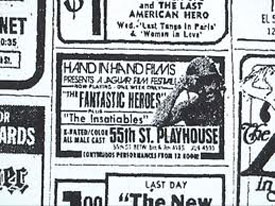

In 1969, Andy Warhol's domination of the New York City gay film scene, at the 55th Street Playhouse, and one straight house, where his gay films played on weekend late shows along with works by other gay film makers, was challenged by a mini-boom in new all male houses, some showing films in addition to stage shows, and, ironically, one house that briefly featured gay videos, but soon switched to regular film.
But even avant garde films that were not explicitly pornographic, the managers of the 55th Street Playhouse discovered, could also cause just as much trouble with the censors.
In June 1970, the theater began screening the new film Censorship in Denmark: A New Approach. The film was ostensibly a documentary study of pornography. The Assistant District Attorney, Richard Beckler, did not agree with that description.

On September 30, theater manager Chung Louis was arrested on the charge of promoting and distributing obscene material.
The film was ordered seized by Criminal Court Judge Jack Rosenberg. The judge ruled “This court finds for the purposes of issuance of a warrant of seizure that Censorship in Denmark, taken as a whole, has as its dominant theme appeals to a prurient interest in sex.”
He added, “It is patently offensive to most Americans because it affronts contemporary community standards relating to the description or representation of sexual matters.”
Now, I wonder, after the 1971 premiers of two classic gay porn films, did the art house became a porn theater overnight?
Perhaps the box office draws of these films caused the Playhouse, like many other Manhattan art houses, to switch to graphic sex films, this one eventually specializing in gay male porn.
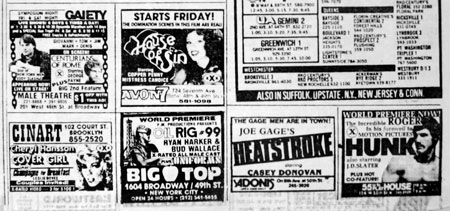
Some time in the 1970s, the Playhouse became part of the porn empire of PM Productions, which produced many of Arch Brown's classic gay porn films.
I have not been able to ascertain when the Playhouse closed and was torn down. One can safely deduce that like many gay porn theaters, the advent of home video in the 1980s pretty much killed its business.
What I think is kind of sad about the ending to this whole fabulously rich history is how the commercialization of gay porn pretty much severed its connection with the avant-garde art film.
And the initial diversity in male images that the films showcased based on specific types who actually lived in the gay culture of the period, such as the young jocks of Nova and the macho men of Colt and the “Castro clones” of Jaguar, ended up by the mid eighties becoming submerged by the mainstream Calvin Klein underwear model.
The place where the Playhouse stood now serves as a delivery entrance for the London NYC hotel.
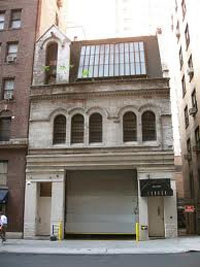

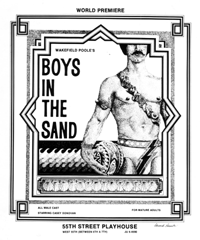


 Join our Email List
Join our Email List Like Us on Facebook
Like Us on Facebook Instagram
Instagram Youtube
Youtube Follow Us on Twitter
Follow Us on Twitter Follow us on Pinterest
Follow us on Pinterest